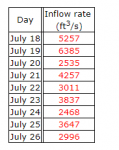I've been trying to solve this question for an good amount of time with no avail, so I've come to seek help on this one:
The table shows the rate of inflow of water, in cubic feet per second, as measured every morning at 7:30 AM by the US Army Corps of Engineers at a lake in Georgia. Use the Midpoint Rule to estimate the amount of water that flowed into this lake from July 18th, 2013 at 7:30 AM to July 26th at 7:30 AM.

I've tried evaluating the midpoints like this: (y1+y2)/2 , (y2+y3)/2 , etc. , summing them all and then multiplying them by 60*60*24 (seconds per day). That was incorrect.
I tried using the sum of y2, y4, y6, y8 and then multiplying that by 2*(seconds per day). That also didn't work, so I am currently stumped on this last question on my assignment.
Please help, thanks.
The table shows the rate of inflow of water, in cubic feet per second, as measured every morning at 7:30 AM by the US Army Corps of Engineers at a lake in Georgia. Use the Midpoint Rule to estimate the amount of water that flowed into this lake from July 18th, 2013 at 7:30 AM to July 26th at 7:30 AM.

I've tried evaluating the midpoints like this: (y1+y2)/2 , (y2+y3)/2 , etc. , summing them all and then multiplying them by 60*60*24 (seconds per day). That was incorrect.
I tried using the sum of y2, y4, y6, y8 and then multiplying that by 2*(seconds per day). That also didn't work, so I am currently stumped on this last question on my assignment.
Please help, thanks.
